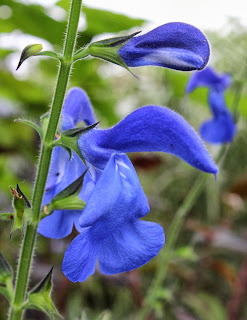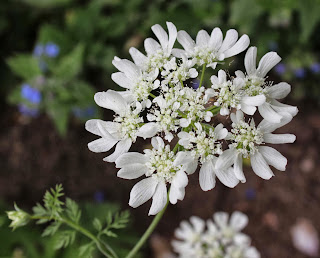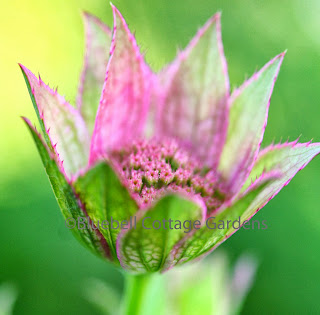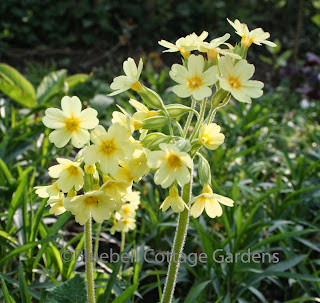 |
| Salvia patens – will flower its socks off until the first frosts. Will survive a mild winter. |
If you read my last blog post you’ll know that I have been harvesting seeds from the garden with merry abandon in the last few weeks.
No plant that I know of drops its seeds into a paper bag, writes the name on the outside, then puts it in a plastic container in a fridge.
Right now Dahlias, Zinnias, Tithonias and Salvia patens are flowering their hearts out as if summer has merely taken a long weekend off. Like revellers on a sinking ship they are wilfully ignoring the warning signals of impending doom, heedless as their sensible neighbours hitch up their fading skirts and dash for the lifeboats.
 |
| Dahlia ‘Arabian Night’. No it doesn’t set seed, but it’s a decent picture of a Dahlia…. |
Brought up in the never ending summers of milder latitudes, the concept of winter has no place in their DNA. They will not harden their stems, or cease flowering to focus on seed production, or shed their leaves to shield themselves against disease and water loss. And when the first frosts bite, the shock may well kill them overnight.
Can we trust a Zinnia or a Dahlia growing outside here in the UK to know when to sow its own seed? I think not.
 |
| Orlaya grandiflora |
So the ‘sow fresh’ rule only really applies to fully hardy plants. But still, why throw your babies out to fend for themselves as the harshest time of year approaches?
I think plants adopt one of two approaches. First up, the hares. Cast your seed now – and plenty of it, let your progeny germinate and get off to a flying start in autumn. Then hope that enough of them survive the winter’s cold, rain and hungry mice. Come spring, those that make it will have a head start over their slumbering rivals and be first to the light and the spring rains. This mainly applies to hardy annuals, like Orlaya grandiflora and biennials, like foxgloves.
 |
| Astrantia maxima – seems to need a winter chill to germinate |
And then there are the tortoises. Some seeds are ‘wired’ to detect temperature or daylength, or a bit of both. Unless it has experienced enough of a cold spell followed by warmer temperatures and longer days to persuade it that winter is over, it will not germinate no matter how much love and attention you bestow on it.
No two plants need exactly the same, but six to ten weeks below 5C seems to do the trick for most seeds. You can do the modern vermiculite-in-a-polythene-bag-in-the-fridge thing, if your fridge-sharing partner doesn’t mind. You could do the old timer’s way of layering seeds and sand in a pot, sinking it into the ground. Or you can do it my way – sow the seeds in seed trays, cover with grit and leave outside, somewhere mouseproof (that’s the hard part). In spring, move the trays into a cool greenhouse and away you go.
Figuring out when winter has happened seems to be the preferred tactic of long-lived perennials like Astrantias and Lamium orvala. It makes perfect sense. These plants are in no rush – they will be around to see many generations of hasty foxgloves come and go.
 |
| Primula elatior (Oxslip) |
You can fool a few plants. Some seed matures on the parent plant and then acquires cold-sensitive dormancy afterwards. So, if you can collect it when it’s mature enough to germinate, but before it becomes dormant, it should germinate promptly. Primulas and Pulsatillas seem to fall into this group – collect Primula seed when it is plump and firm, but still green.
A few plants adopt a full belt-and-braces approach. Actaea pachypoda seeds (pictured on my earlier blog) need not one winter, but two before they will germinate, just to be absolutely sure that they’ve got their timing right. Patience is the only method.
Others, like Trilliums, tentatively grow only a root in the first year, waiting until their second spring to send a shoot into the light.
 |
| Verbena bonariensis – a bit on the tender side so sow in spring. Small Copper supplied separately. |
So, where does this leave the confused seed sower? For perennials, if the plant is tender, or can’t always be relied on to overwinter, sow in spring. I prefer to sow hardy annuals in spring too as I seem to lose too many autumn sown seedlings.
I sow seeds of all hardy perennials in September – if I’ve got space. They get two months to live quietly in the cool greenhouse, and if they germinate they can stay there for winter. If they don’t, the trays go outside from November to early February and are then moved back into the cold greenhouse. Any that still don’t germinate get pushed into a corner somewhere and left for another year – if the plant is worth it.
Recent Comments